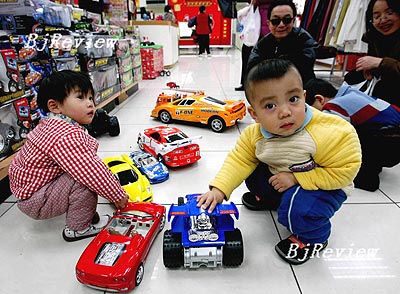
On August 11, a Hong Kong toy maker committed suicide days after his longtime U.S. customer Mattel Inc. recalled 967,000 toys made with paint found to include excessive amount of lead.
Cheung Shu-hung, who co-owned Lee Der Industrial Co. Ltd., hung himself at his factory's warehouse over the weekend in southern China's Guangdong Province, after the Chinese Government announced that his company was prohibited from exporting products and was under investigation.
Cheung's death is seen as a tragic symbol of the mounting pressure Chinese manufacturers face to improve their operations as Chinese products come under increasing pressure because of safety and quality issues. The loss his company suffered from the recall is estimated to exceed $30 million.
An unprecedented challenge lies ahead for China's toy manufacturers. Many of them are running at a loss due to the higher standards of quality put forward by the international community. Having no other alternative, some quit while others shift their business models.
Following the enactment of new EU and U.S. standards on the quality and safety of toys, the Chinese Government has also imposed the China Compulsory Certification (CCC) scheme for six categories of toys on toy makers. Starting from June 1, 2007, only those toys that meet CCC standards will be allowed sale at home and for export to overseas markets.
A direct result of the new standards is an 8-percent increase in the production costs of Chinese toy makers as 80 percent of their products are exported overseas, mainly to the United States and the EU. These toy makers, usually reaping a 2-3 percent profit margin, are confronted with the possibility of making little to no profits due to the increase in production costs. Besides this, a large number of exported toys that failed to meet the new standards have been recalled, and companies involved are running at a loss where workers are soon to face unemployment.
The plight of Santa's elves
Goods "made in China" can be found in every corner of the globe, especially toy products. China is the world's largest toy maker and exporter, and about three-quarters of toys produced in the world carry the "made-in-China" label.
Despite that, toy manufacturing in China yields toy makers a marginal profit.
"Toy dealers overseas make the lion's share [of the profits], " said Zhan Wanlin, Deputy Manager of Anhui Daily-Play Toys (Group) Co. Ltd.
Anhui Daily-Play Toys started business two decades ago by making plush toys and dolls that are sold abroad under a foreign company's label, or as original equipment manufacturers (OEMs). Franchisers overseas offer the design, materials and pricing, while Daily-Play Toy is responsible for production and processing. According to Zhan, the company's profit margin is about 2 percent.
Like the Daily-Play, 70 percent of toy makers in China are OEM toy manufacturers, either processing with supplied materials or with foreign designs. This means that the toy dealers overseas are the big bosses instead of locals.
As such a labor-intensive industry, China's toy manufacturing sector suffers from a lack of innovation and technological upgrades. Without advantages in design and R&D, few toy makers export products under their own brands.
Shi Xiaoguang, Chairman of the China Toy Association, said that even though China is known as a major toy manufacturer, it lacks major toy making brands and professional, quality toy developers. As a result, no company has the sufficient capital and technology to establish its own brand. China's toy manufacturing industry is located at the downstream of the industry value chain, enjoying low added value.
High hurdles
While new EU and U.S. toy safety standards brought an 8-percent increase in production costs, raw materials and labor-related costs also increased at the same time the Chinese currency rose over 7 percent. While operation costs soar, there is limited room for price rises. As a result, profit margins are shrinking fast. Zhan said that suggestions to increase the prices of toys have been dismissed by toy dealers overseas.
Quite a number of toy makers with low or even no gross profit have had to close their factories, quit the business, or shift to other industries. They either go into the foreign trade business, become suppliers of toy materials, or are forced to close.
Zhan said that Daily-Play Toy is now shifting its focus to bedclothes, though still retaining the toy manufacturing business.
Realizing that there is no money to make exporting toys, those beyond average size have an eye on the domestic toy market. A report from the China Toy Association shows that Chinese urban and rural residents are spending more on toys. Around 20 percent, or 360 million, of the Chinese population is less than 16 years old. Currently, Chinese families spend 30 percent of their total expenditures on children, and monthly spending related to children aged from 1 to 12 nationwide has reached an aggregate of 3.5 billion yuan. However, average annual spending on toys per child (less than 14 years old) in China is 20-30 yuan, or $2.6 to $4, much less than the average of $13 in Asia and the world average of $34. If Chinese parents spend the Asian average of $13 every year on toys for children, the market potential will exceed 30 billion yuan, or $3.95 billion.
According to the association, the domestic toy market is expected to increase 40 percent annually, with total sales surpassing 100 billion yuan by 2010.
| 